 W
WThe Astra A-60 is a double-action, single-action, semi-automatic pistol at one time produced in Spain by Astra-Unceta y Cia SA. The design is similar to the Walther PP and features a slide-lock release lever.
 W
WThe Beholla pistol was developed by Becker & Hollander. During World War I, it was a secondary military pistol used by the Imperial German Army. It was manufactured from 1915 until 1918, where, at that point, about 45,000 were produced.
 W
WThe B76 is a pistol manufactured in Italy by Benelli.
 W
WThe Beretta 70 is a magazine-fed, single-action semi-automatic pistol series designed and produced by Beretta of Italy, which replaced the earlier 7.65mm Beretta M1935 pistol. Some pistols in this series were also marketed as the Falcon, New Puma, New Sable, Jaguar, and Cougar. The gun is notable for its appearances in film, and is also the first compact Beretta pistol to feature several improvements commonly found in Beretta pistols for the rest of the century.
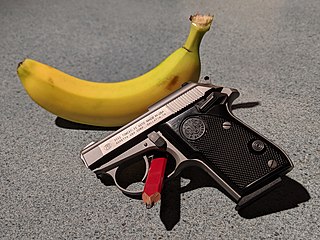 W
WThe Beretta 3032 Tomcat and Beretta 3032 Tomcat Inox are semi-automatic pocket pistols designed and manufactured by Beretta. They are chambered in .32 ACP and are small pistols, designed for concealed-carry and use as backup weapons. The Beretta 3032 Tomcat builds on a long line of small and compact pocket pistols for self defense manufactured by Beretta. The allure and popularity is commonly attributed to the loading procedure, which does not require the user to "rack" the slide to chamber a round, but rather place a round in the tip-up barrel before the magazine is inserted. This is especially popular for those with weaker or smaller hands.
 W
WThe Beretta Cheetah, also known by its original model name of "Series 81", is a line of compact blowback operated semi-automatic pistols designed and manufactured by Beretta of Italy. They were introduced in 1976 and include models in .32 ACP, .380 ACP and .22 LR. Beretta still manufactures the Cheetah in Italy with limited imports to the U.S. each year.
 W
WThe Beretta M1935 is a compact .32 ACP caliber blowback pistol that was manufactured by Italian firm Beretta.
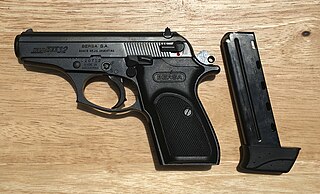 W
WThe Bersa Thunder 32 is a lightweight, relatively small semi-automatic pistol chambered in .32 ACP caliber made by Argentine firearms manufacturer Bersa, S.A.
 W
WThe Colt Model 1903 Pocket Hammerless is a .32 ACP caliber, self-loading, semi-automatic pistol designed by John Browning and built by Colt Patent Firearms Manufacturing Company of Hartford, Connecticut. The Colt Model 1908 Pocket Hammerless is a variant introduced five years later in .380 ACP caliber. Despite the title "hammerless", the Model 1903 does have a hammer. The hammer is covered and hidden from view under the rear of the slide. This allows the pistol to be carried in and withdrawn from a pocket quickly and smoothly without snagging.
 W
WThe Česká zbrojovka Vz. 82 is a compact semi-automatic pistol made for the Czechoslovakian military. "Vz" is an abbreviation for "vzor", which translates to "model." A civilian export version is called the CZ 83.
 W
WImage is NOT a CZ-27 but rather a CZ-24. CZ-27 and CZ-24 look similar but slide serrations on CZ-27 are vertical and on CZ-24 slide serrations are slanted.
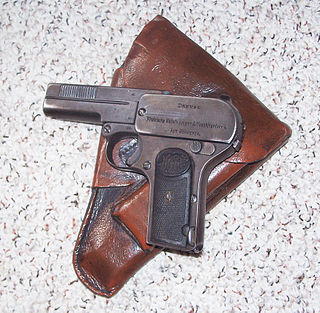 W
WThe Dreyse Model 1907 is a semi-automatic pistol designed by Louis Schmeisser. The gun was named after Nikolaus von Dreyse, the designer of the Dreyse Needle Gun. The Waffenfabrik von Dreyse company was acquired by Rheinische Metallwaren & Maschinenfabrik Sömmerda in 1901, although the Dreyse Model pistols were marketed under the Dreyse name.
 W
WThe P-83 Wanad is a single-action and double-action Polish semi-automatic pistol, chambered for the 9×18mm Makarov cartridge and designed by Ryszard Chełmicki and Marian Gryszkiewicz of the state research institute Ośrodek Badawczo-Rozwojowy in Radom. The P-83 succeeded the P-64 as the sidearm for the Polish Army and police. The P-83 is still in limited use by both the Polish police and the Polish military but it has been mostly replaced by Glock 19 pistols in Police service and partially by the indigenous WIST 94 pistol in the Polish military.
 W
WThe FÉG 37M is a Hungarian semi-automatic pistol based on a design by Rudolf Frommer.
 W
WThe FÉG PA-63 is a semi-automatic pistol designed and manufactured by the FÉGARMY Arms Factory of Hungary.
 W
WThe FN Browning M1900 is a single action, semi-automatic pistol designed c. 1896 by John Browning for Fabrique Nationale de Herstal (FN) and produced in Belgium at the turn of the century. It was the first production handgun to use a slide.
 W
WThe FN Model 1910 is a blowback-operated, semi-automatic pistol designed by John Browning and manufactured by Fabrique Nationale of Belgium.
 W
WThe Frommer Stop is a Hungarian long-recoil, rotating bolt pistol manufactured by Fémáru, Fegyver és Gépgyár (FÉG) in Budapest. It was designed by Rudolf Frommer, and its original design was adopted as the Pisztoly 12M in 1912, created for the Royal Hungarian Army. The handgun was manufactured in various forms from 1912 to 1945 and used in the Hungarian Armed Forces as well as, during the First World War, by military of the Ottoman Empire in limited quantities. The Stop is 165 millimeters (6.5 in) long with a 95 millimeters (3.7 in) 4-groove rifled barrel. Unloaded weight is 610 g (22 oz), and the detachable box magazine holds seven rounds.
 W
WThe HK 4 pocket pistol was first introduced by Heckler & Koch in 1967. Government agencies received 12,000 pistols in the .32 ACP caliber with the designation P11 and were serial numbered 40001 to 52400.
 W
WThe JO.LO.AR. was a semi-automatic pistol of Spanish origin and is chambered in various calibres. It is a development of the Extractor Model Sharpshooter pistol and was manufactured from 1924 by Bonifacio Echeveria STAR, with patent by J. Lopez de Arnaiz and renamed the JO-LO-AR, hence the designer's initials.
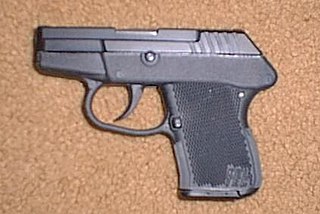 W
WThe Kel-Tec P-32 is a sub-compact semi-automatic pistol using the short-recoil principle of operation that is chambered in .32 ACP. It was designed by George Kellgren. It is manufactured by Kel-Tec CNC Industries Inc., of Cocoa, Florida and was designed for concealed carry by citizens and by law enforcement officers as a back-up gun.
 W
WThe Le Français pistol by Manufrance was produced from 1913 till 1969, in a variety of calibres. It was mainly sold in France, primarily to the greater public but also to some officers of the French Army, and to the French municipal police. In 1912, Etienne Mimard the Head of Manufrance started development. Mr. Mimard obtained the patent for the first model on August 6, 1913 with n° 472.505. Sales started in 1914 with the name "Le Français".
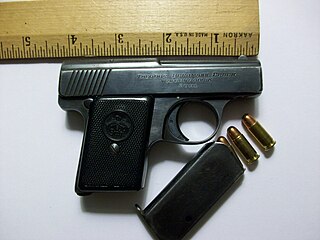 W
WThe 4.25 mm Liliput pistol is one of the smallest semiautomatic handguns ever made. Hence its name, derived from the fictional island of Lilliput, inhabited by tiny people.
 W
WThe MAB model D is a pistol produced by MAB from 1933 to 1963 and 1982 ; it was inspired by the Belgian Browning FN pistol 1910/22.
 W
WThe Mauser HSc is a 7.65mm pistol made in Nazi Germany during World War II and post-war. The designation HSc stood for Hahn Selbstspanner Pistole, third and final design "C". Production was continued in 1945–46 during the French occupation and, later, from 1968 to 1977 by Mauser. It features a semi-exposed hammer, double-action trigger, single-column magazine, and a spring surrounding the barrel.
 W
WThe Mauser Model 1914 is a semi-automatic pistol made by Mauser. A derivative of the .25 caliber Model 1910 designed by Josef Nickl, it uses 32 ACP ammunition.
 W
WThe New Nambu M57 (ニューナンブM57) is a series of semi-automatic pistols designed by Shin-Chuō Industries, later merged with Minebea. "New Nambu" was named after Kijirō Nambu, a notable firearm designer and the founder of Shin-Chuō Industries.
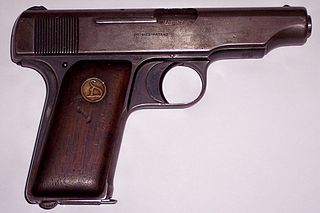 W
WThe Ortgies 7.65 mm pistol was a hammerless semi-automatic pistol produced in Germany in the years immediately after World War I, first by its inventor Heinrich Ortgies and then by Deutsche Werke. Inexpensive, but of good quality, the pistol achieved considerable success at contemporary shooting competitions and, as an export product, was popular throughout the Americas.
 W
WThe Pindad P3 is a double action/single action semi-automatic pistol made by PT Pindad, intended to be a compact and unobtrusive pistol. The Pindad P3 is chambered in .32 ACP and has a magazine capacity of 12. The sight on the P3 is a tritium three dot sight that was also used on the P1 and P2.
 W
WPistolul calibrul 7,65mm Model 1974, also known as Pistolul Carpați, is a series of light semi-automatic pistols designed and manufactured by Fabrica de Arme Cugir of Romania. It was initially introduced as a side-arm for submachine gun equipped units of the Romanian Army and is currently issued as a self-defence weapon in the Romanian Police.
 W
WThe pistole vz. 24 was the standard Czech Army pistol of the inter-war period. It was an improved version of the pistole vz. 22, which had been licensed from Mauser. Slovakia seized over ten thousand vz. 24s when it declared its independence from Czechoslovakia in March 1939. The vz. 24 was succeeded in production by a simplified version chambered in .32 ACP, the vz. 27.
 W
WThe Prilutsky M1914 was a semi-automatic pistol that was designed in the Russian Empire. It was supposedly to be used by the Imperial Russian Army but it was canceled due to the start of the First World War.
 W
WThe Remington Model 51 is a small pocket pistol designed by John Pedersen and manufactured by Remington Arms in the early 20th century for the American civilian market. Remington manufactured approximately 65,000 Model 51 pistols in .32 ACP and .380 ACP calibers from 1918 to 1927, though small numbers were assembled into the mid-1930s.
 W
WThe self-loading Ruby pistol is best known as a French World War I sidearm, the Pistolet Automatique de 7 millim.65 genre "Ruby". A very international piece of weaponry, it was closely modeled after John Browning's 1903 Pocket Hammerless design produced by Colt, and was produced by over 50 Spanish companies, but primarily by the Spanish Gabilondo y Urresti firm. It was decommissioned in 1958, more than a decade after World War II was brought to an end, and was subsequently replaced.
 W
WThe Sauer 38H or often just H was a small semi-automatic pistol made in Nazi Germany from 1938 until just after the end of World War II by J. P. Sauer & Sohn, then based in Suhl, Germany. The "H" in the model number is short for "hahn", referring to the internal hammer of the firing mechanism.
 W
WThe Savage Model 1907 is a semi-automatic pocket pistol produced by the Savage Arms, from 1907 until 1920. It was chambered in .32 ACP and, from 1913 until 1920, in .380 ACP. Although smaller in size, it is derived from the .45 semi-automatic pistol Savage submitted to the 1906-1911 US Army trials to choose a new semi-automatic sidearm. After several years of testing the Savage pistol was one of two finalists but ultimately lost to the Colt entry, which became famous as the Colt Model 1911. 181 of these .45 ACP pistols were returned to Savage after the testing and sold on the civilian market.
 W
WThe Schwarzlose Model 1908 was a semi-automatic pistol, designed by Andreas Schwarzlose, released in 1908 in the German Empire and produced until 1911.
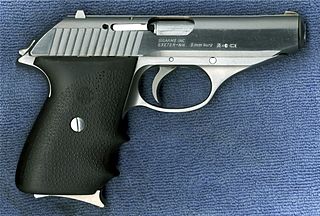 W
WThe SIG Sauer P230 is a small, semi-automatic handgun chambered in .32 ACP or .380 Auto. It was designed by SIG Sauer of Eckernförde, Germany. It was imported into the United States by SIGARMS in 1985. In 1996 it was replaced by the model P232.
 W
WThe Star Model 1914 was produced by Star Bonifacio Echeverria S.A., and largely an improved version of the Star Model 1908, particularly in terms of ergonomics. This model was chosen by the French Army in 7.65mm Browning calibre, also called the Pistolet automatique Star. Based on the Mannlicher 1901/1905, it was produced in 1919 in two versions which varied in dimensions and capacity. It was carried by the French in both World Wars. Its construction and reputation were better than that of the Ruby Llama.
 W
WThe Taurus Millennium series is a product line of double-action only (DAO) and single-action/double-action hammerless, striker-fired, short recoil operated, semi-automatic pistols manufactured by Forjas Taurus S/A in Porto Alegre Brazil. The Millennium line was designed to contend in the civilian concealed carry firearms market, and to be sold as backup weapons for law enforcement officers.
 W
WThe Taurus PT92 is a double action/single action, 9mm, double-stack-magazine fed, short recoil-operated, semi-automatic pistol manufactured by Taurus in the former Beretta factory in São Paulo, Brazil.
 W
WThe Hamada Type 1 or Hamada Type Automatic handgun was a semi-automatic pistol developed starting in 1941 for use by the Empire of Japan during World War II. Developed by Bunji Hamada, the pistol took its basic design from the Model 1910 Browning. Production occurred at the Japanese Firearms Manufacturing Company, with only minor changes made as the war progressed.
 W
WThe Vz. 50 is a Czech made double-action, semi-automatic pistol. Vz is an abbreviation of the Czech term "vzor" meaning model.
 W
WThe Walther PP series pistols are blowback-operated semi-automatic pistols, developed by the German arms manufacturer Carl Walther GmbH Sportwaffen.
 W
WThe Zastava M70, formerly designated CZ M70 is semi-automatic pistol produced by Zastava Arms as a sidearm for Yugoslav police and certain military officers. The pistol was loosely based on the Zastava M57, but is scaled down to accept the smaller and less powerful 7,65mm Browning or 9mm Kratak.